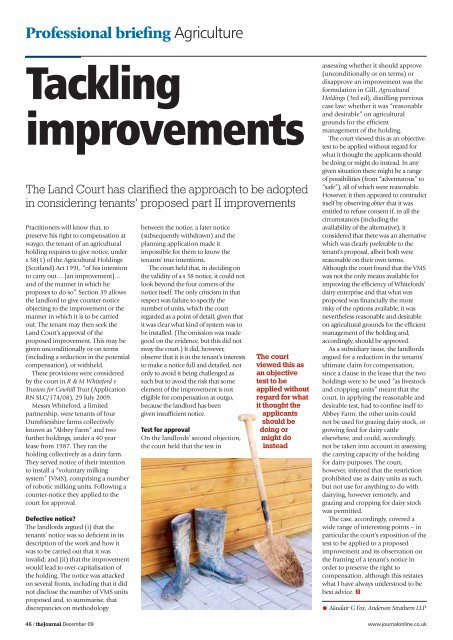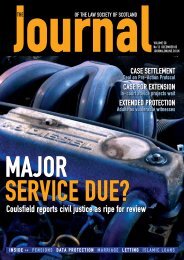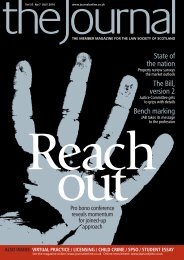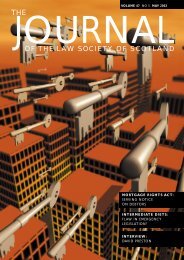Professional briefing - The Journal Online
Professional briefing - The Journal Online
Professional briefing - The Journal Online
You also want an ePaper? Increase the reach of your titles
YUMPU automatically turns print PDFs into web optimized ePapers that Google loves.
<strong>Professional</strong> <strong>briefing</strong> Agriculture<br />
Tackling<br />
improvements<br />
<strong>The</strong> Land Court has clarified the approach to be adopted<br />
in considering tenants’ proposed part II improvements<br />
Practitioners will know that, to<br />
preserve his right to compensation at<br />
waygo, the tenant of an agricultural<br />
holding requires to give notice, under<br />
s 38(1) of the Agricultural Holdings<br />
(Scotland) Act 1991, “of his intention<br />
to carry out… [an improvement]…<br />
and of the manner in which he<br />
proposes to do so”. Section 39 allows<br />
the landlord to give counter-notice<br />
objecting to the improvement or the<br />
manner in which it is to be carried<br />
out. <strong>The</strong> tenant may then seek the<br />
Land Court’s approval of the<br />
proposed improvement. This may be<br />
given unconditionally or on terms<br />
(including a reduction in the potential<br />
compensation), or withheld.<br />
<strong>The</strong>se provisions were considered<br />
by the court in R & M Whiteford v<br />
Trustees for Cowhill Trust (Application<br />
RN SLC/174/08), 29 July 2009.<br />
Messrs Whiteford, a limited<br />
partnership, were tenants of four<br />
Dumfriesshire farms collectively<br />
known as “Abbey Farm” and two<br />
further holdings, under a 40 year<br />
lease from 1987. <strong>The</strong>y ran the<br />
holding collectively as a dairy farm.<br />
<strong>The</strong>y served notice of their intention<br />
to install a “voluntary milking<br />
system” (VMS), comprising a number<br />
of robotic milking units. Following a<br />
counter-notice they applied to the<br />
court for approval.<br />
Defective notice?<br />
<strong>The</strong> landlords argued (i) that the<br />
tenants’ notice was so deficient in its<br />
description of the work and how it<br />
was to be carried out that it was<br />
invalid; and (ii) that the improvement<br />
would lead to over-capitalisation of<br />
the holding. <strong>The</strong> notice was attacked<br />
on several fronts, including that it did<br />
not disclose the number of VMS units<br />
proposed and, to summarise, that<br />
discrepancies on methodology<br />
46 / the<strong>Journal</strong> December 09<br />
between the notice, a later notice<br />
(subsequently withdrawn) and the<br />
planning application made it<br />
impossible for them to know the<br />
tenants’ true intentions.<br />
<strong>The</strong> court held that, in deciding on<br />
the validity of a s 38 notice, it could not<br />
look beyond the four corners of the<br />
notice itself. <strong>The</strong> only criticism in that<br />
respect was failure to specify the<br />
number of units, which the court<br />
regarded as a point of detail, given that<br />
it was clear what kind of system was to<br />
be installed. (<strong>The</strong> omission was made<br />
good on the evidence, but this did not<br />
sway the court.) It did, however,<br />
observe that it is in the tenant’s interests<br />
to make a notice full and detailed, not<br />
only to avoid it being challenged as<br />
such but to avoid the risk that some<br />
element of the improvement is not<br />
eligible for compensation at outgo,<br />
because the landlord has been<br />
given insufficient notice.<br />
Test for approval<br />
On the landlords’ second objection,<br />
the court held that the test in<br />
<strong>The</strong> court<br />
viewed this as<br />
an objective<br />
test to be<br />
applied without<br />
regard for what<br />
it thought the<br />
applicants<br />
should be<br />
doing or<br />
might do<br />
instead<br />
assessing whether it should approve<br />
(unconditionally or on terms) or<br />
disapprove an improvement was the<br />
formulation in Gill, Agricultural<br />
Holdings (3rd ed), distilling previous<br />
case law: whether it was “reasonable<br />
and desirable” on agricultural<br />
grounds for the efficient<br />
management of the holding.<br />
<strong>The</strong> court viewed this as an objective<br />
test to be applied without regard for<br />
what it thought the applicants should<br />
be doing or might do instead. In any<br />
given situation there might be a range<br />
of possibilities (from “adventurous” to<br />
“safe”), all of which were reasonable.<br />
However, it then appeared to contradict<br />
itself by observing obiter that it was<br />
entitled to refuse consent if, in all the<br />
circumstances (including the<br />
availability of the alternative), it<br />
considered that there was an alternative<br />
which was clearly preferable to the<br />
tenant’s proposal, albeit both were<br />
reasonable on their own terms.<br />
Although the court found that the VMS<br />
was not the only means available for<br />
improving the efficiency of Whitefords’<br />
dairy enterprise and that what was<br />
proposed was financially the more<br />
risky of the options available, it was<br />
nevertheless reasonable and desirable<br />
on agricultural grounds for the efficient<br />
management of the holding and,<br />
accordingly, should be approved.<br />
As a subsidiary issue, the landlords<br />
argued for a reduction in the tenants’<br />
ultimate claim for compensation,<br />
since a clause in the lease that the two<br />
holdings were to be used “as livestock<br />
and cropping units” meant that the<br />
court, in applying the reasonable and<br />
desirable test, had to confine itself to<br />
Abbey Farm: the other units could<br />
not be used for grazing dairy stock, or<br />
growing feed for dairy cattle<br />
elsewhere, and could, accordingly,<br />
not be taken into account in assessing<br />
the carrying capacity of the holding<br />
for dairy purposes. <strong>The</strong> court,<br />
however, inferred that the restriction<br />
prohibited use as dairy units as such,<br />
but not use for anything to do with<br />
dairying, however remotely, and<br />
grazing and cropping for dairy stock<br />
was permitted.<br />
<strong>The</strong> case, accordingly, covered a<br />
wide range of interesting points – in<br />
particular the court’s exposition of the<br />
test to be applied to a proposed<br />
improvement and its observation on<br />
the framing of a tenant’s notice in<br />
order to preserve the right to<br />
compensation, although this restates<br />
what I have always understood to be<br />
best advice.<br />
Alasdair G Fox, Anderson Strathern LLP<br />
www.journalonline.co.uk










